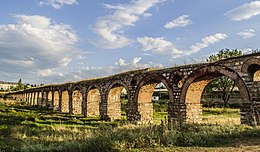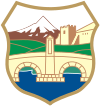Skopje Aqueduct
Skopje Aqueduct | |
|---|---|
 | |
| Coordinates | 42°01.411′N 021°25.124′E / 42.023517°N 21.418733°ECoordinates: 42°01.411′N 021°25.124′E / 42.023517°N 21.418733°E |
| Carries | Skopje Aqueduct |
| Locale | Vizbegovo near Skopje, North Macedonia |
| Characteristics | |
| Material | Brick, stone |
| Total length | 386 m (1,266 ft) |
| Height | 16.5 m (54 ft) |
| History | |
| Construction end | reign of Justinian I (527 – 565) or during the reign of Ottomans (16th century) |
| Location | |
 | |

The Skopje Aqueduct (Macedonian: Скопски аквадукт, Albanian: Akudukti) is an aqueduct and archaeological site located in the neighbourhood of Vizbegovo 2 km (1.2 mi) northwest of central Skopje, North Macedonia. The Skopje Aqueduct is the only aqueduct in Macedonia, and one of three largest and well preserved in the former Yugoslavia along with Diocletianus Aqueduct near Split, Croatia and Bar Aqueduct in Montenegro.
History[]
The question of when the Skopje Aqueduct was built is unclear. There are three theories:
- during the reign of Rome (1st century); according to this theory the aqueduct fed water to Legionary settlement Scupi.
- during the reign of Byzantine Empire (reign of Emperor Justinian I); according to this theory, the aqueduct shipped water to the new settlement Justiniana Prima.[1]
- during the reign of Ottoman Empire; according to this theory the aqueduct was built in the 16th century for the many Turkish public hamams.[2]
This aqueduct was in use until the eighteenth century. Only about 386 meters (1,266 ft) with 55 arches of this structure of stone and brick remain. It is assumed that the aqueduct took water from the spring Lavovec (village Gluvo in mountain Skopska Crna Gora), 9 kilometers (5.6 mi) northwest from Skopje and brought water to city center.
See also[]
- List of aqueducts in the Roman Empire
- List of Roman aqueducts by date
- Ancient Roman technology
- Roman engineering
Bibliography[]
- (in Macedonian) Petrov K, «Akvedukt kraj Skopje i problemot na negovata datiranje», Godisen Zbornik na Filozofski Fakultet, 13 (1962).
References[]
- ^ According to this theory, Justiniana Prima, was somewhere near the Skopje Fortress, and not, as is usually considered in Lebane Serbia, at the site Caričin Grad.
- ^ (in Macedonian) Аквадукт Скопје, www.architect.mk, accessdate=2010-08-25 Archived 2010-09-18 at the Wayback Machine
External links[]
| Wikimedia Commons has media related to Skopje Aqueduct. |
- (in Macedonian) Аквадуктот во Скопје, on site utrinski vesnik
- (in Macedonian) Игор Василевски:Аквадукт Скопје,on site www.architect.mk
- (in Macedonian) Аквaдукт Скопје ... Akvadukt Skopje ... Aqueduct Skopje on site volanskopje (photos)
- Archaeological sites in North Macedonia
- Aqueducts in North Macedonia
- Buildings and structures in Skopje
- Roman aqueducts outside Rome



